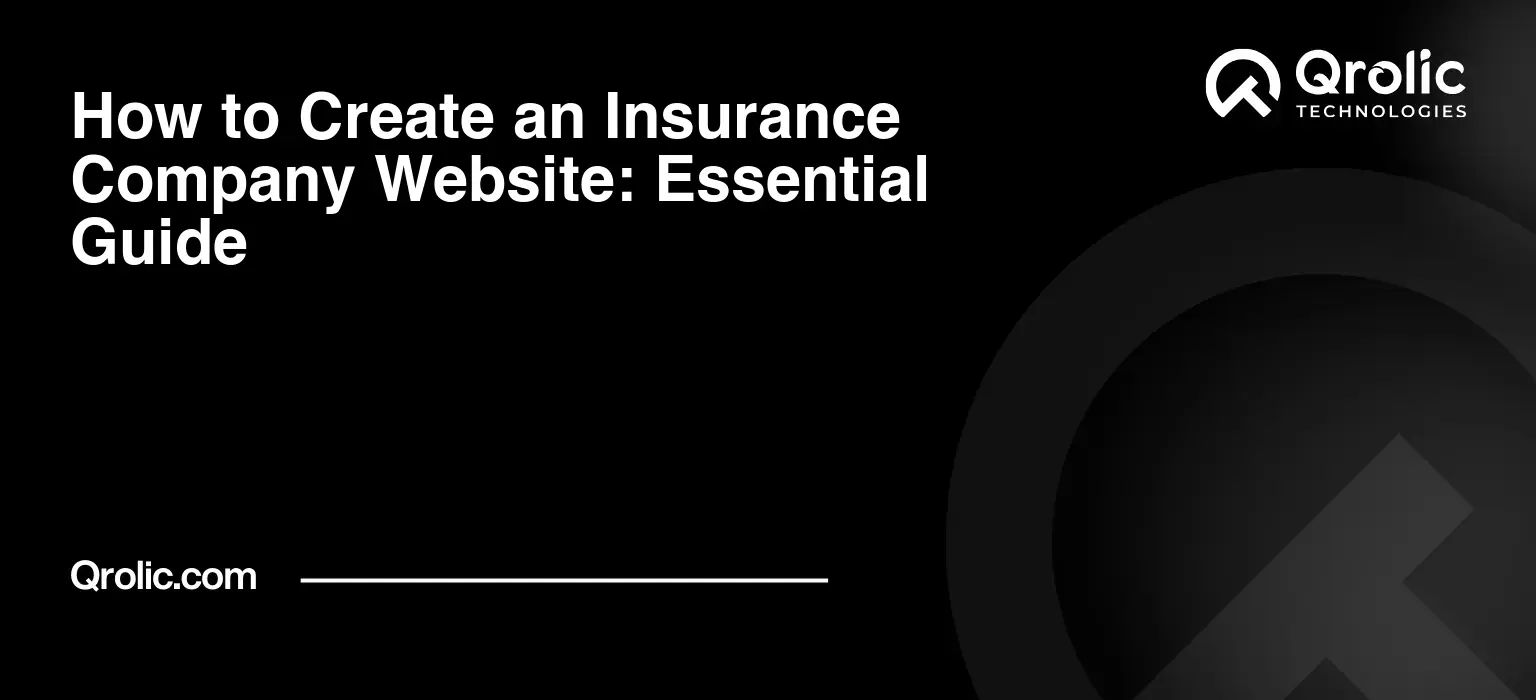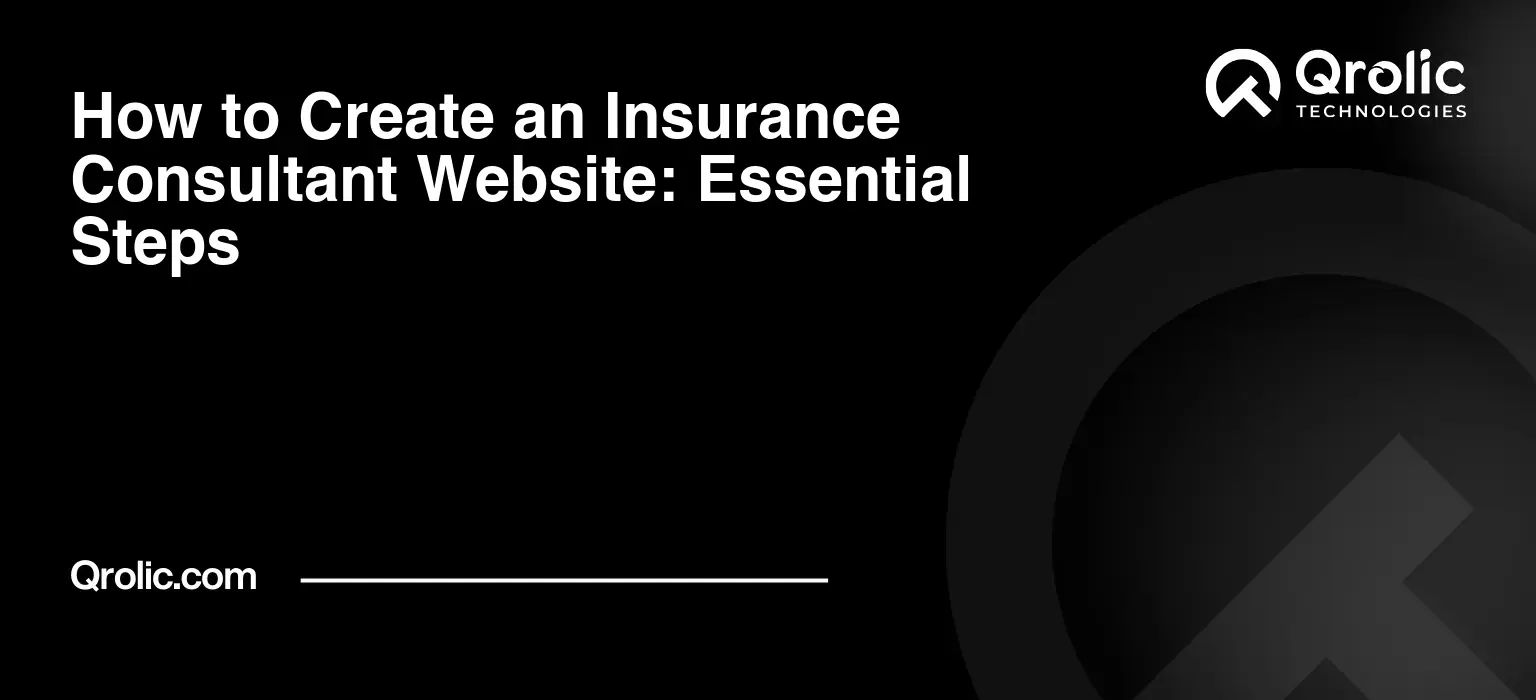Quick Summary:
- Your website is your agency’s essential digital storefront.
- Ensure your site is user-friendly, secure, and mobile-ready.
- Create valuable content and optimize for search engines.
- Offer online quotes and client portals for great service.
Table of Contents
- The Digital Landscape: Why Your Insurance Agency Needs a Killer Website
- The Shifting Sands of Insurance: From Face-to-Face to Digital Embrace
- The Power of First Impressions: Website Design and Client Perception
- Beyond the Brochure: The Website as a Customer Service Hub
- Essential Elements of an Effective Insurance Agency Website
- User-Friendly Navigation: Guiding Clients to the Right Coverage
- Compelling Content: Building Trust and Authority
- Quote Forms and Contact Information: Making it Easy to Connect
- Mobile-First Design: Reaching Clients On the Go
- Security and Trust Signals: Reassuring Clients Their Information is Safe
- SEO Strategies for Insurance Agency Websites: Getting Found Online
- Keyword Research: Identifying the Terms Your Clients Are Searching For
- On-Page Optimization: Optimizing Your Website for Search Engines
- Off-Page Optimization: Building Authority and Reputation
- Local SEO: Targeting Clients in Your Geographic Area
- Content Marketing: Attracting and Engaging Potential Clients
- Beyond the Basics: Advanced Website Features for Insurance Agencies
- Online Quoting Tools: Streamlining the Sales Process
- Client Portals: Providing Secure Access to Policy Information
- CRM Integration: Managing Client Relationships Effectively
- Live Chat Support: Providing Instant Assistance to Website Visitors
- Multi-Lingual Support: Reaching a Wider Audience
- Measuring Success: Website Analytics and Key Performance Indicators (KPIs)
- Tracking Website Traffic: Understanding Where Your Visitors Are Coming From
- Monitoring Conversion Rates: Measuring the Effectiveness of Your Website
- Analyzing User Behavior: Understanding How Visitors Interact With Your Website
- Key Performance Indicators (KPIs): Tracking the Metrics That Matter Most
- Qrolic Technologies: Your Partner in Insurance Agency Website Design
- The Future of Insurance Agency Websites: Trends to Watch
- Artificial Intelligence (AI) and Chatbots: Personalized Customer Interactions
- Video Marketing: Engaging Content That Converts
- Voice Search Optimization: Preparing for the Future of Search
- Data Analytics and Personalization: Delivering Tailored Experiences
- Accessibility: Ensuring Your Website is Usable by Everyone
The Digital Landscape: Why Your Insurance Agency Needs a Killer Website
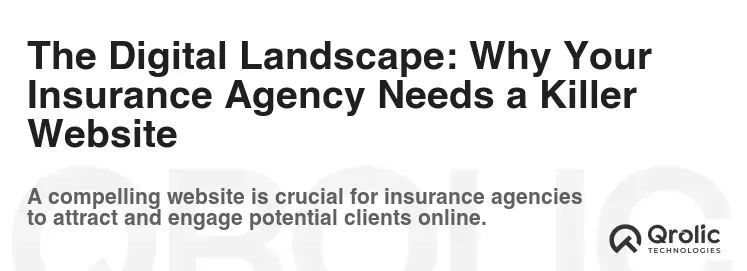
The Shifting Sands of Insurance: From Face-to-Face to Digital Embrace
The insurance industry, once heavily reliant on personal interactions and local presence, is undergoing a seismic shift. Consumers are increasingly turning to the internet to research policies, compare quotes, and even purchase coverage. A strong online presence is no longer a luxury; it’s a necessity for survival and thriving in today’s competitive market. Think of it like this: your website is the new storefront, the digital handshake, the first impression you make on potential clients. It’s where trust begins to build, where credibility is established, and where conversions happen. Ignoring this reality means leaving business on the table, handing opportunities to your competitors who understand the power of a well-designed website.
The Power of First Impressions: Website Design and Client Perception
Imagine walking into an office for the first time. What makes you stay? The friendly receptionist, the clean and organized space, the overall feeling of professionalism. Your website is that first impression online. A poorly designed website screams “unprofessional,” “outdated,” or even “untrustworthy.” It can instantly turn potential clients away, no matter how excellent your insurance services might be. A well-designed website, on the other hand, projects competence, reliability, and a commitment to customer service. It says, “We understand your needs and are here to help.” It’s an investment in your brand image and a crucial factor in attracting and retaining clients.
Beyond the Brochure: The Website as a Customer Service Hub
Forget static brochures and outdated information. Your website should be a dynamic, interactive hub that provides valuable information and supports your clients throughout their insurance journey. It’s a place where they can find answers to frequently asked questions, access policy documents, file claims, and even connect with you directly. By offering self-service options and easy access to information, you not only improve customer satisfaction but also free up your staff to focus on more complex issues. Think of your website as a 24/7 customer service representative, always available to assist your clients, even outside of business hours.
Essential Elements of an Effective Insurance Agency Website
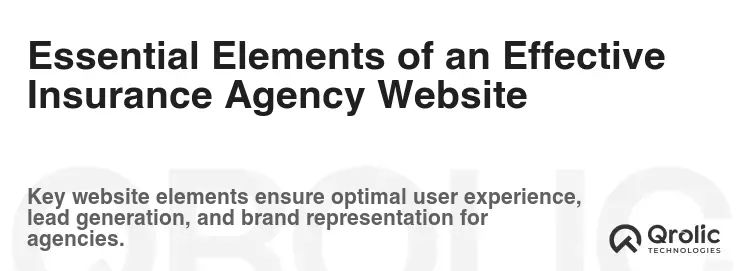
User-Friendly Navigation: Guiding Clients to the Right Coverage
Imagine a labyrinth with no map. Frustrating, right? That’s what a poorly navigated website feels like to a user. Clear, intuitive navigation is paramount. Your website should be easy to browse, with logically organized content and a clear path to the information users are seeking. Use drop-down menus, search bars, and internal links to guide visitors to the right pages. Think like a client: what information are they most likely looking for? Make it easily accessible and prominent on your website.
- Clear Menu Structure: Organize your services by type of insurance (e.g., auto, home, life, business).
- Search Functionality: Implement a robust search bar to allow users to quickly find specific keywords or topics.
- Breadcrumbs: Use breadcrumbs to show users their location within the website and allow them to easily navigate back.
- Mobile-Friendly Design: Ensure your navigation works flawlessly on all devices, especially mobile phones.
Compelling Content: Building Trust and Authority
Content is king, especially in the insurance industry. Potential clients are looking for information they can trust, explanations they can understand, and reassurance that they are making the right decision. Your website content should be informative, engaging, and tailored to your target audience. Avoid jargon and technical terms that might confuse or intimidate potential clients. Instead, focus on explaining complex topics in a clear, concise, and human-friendly way.
- Informative Blog: Regularly publish blog posts on topics related to insurance, risk management, and financial planning.
- FAQ Section: Answer frequently asked questions about your services and the insurance industry in general.
- Client Testimonials: Showcase positive feedback from satisfied clients to build trust and credibility.
- Case Studies: Share real-life examples of how your insurance services have helped clients in specific situations.
Quote Forms and Contact Information: Making it Easy to Connect
The ultimate goal of your website is to generate leads and convert visitors into clients. Make it easy for potential clients to get a quote or contact you directly. Prominently display your phone number, email address, and physical address on every page of your website. Implement user-friendly quote forms that allow visitors to request a quote for specific types of insurance. Consider using a live chat feature to provide instant support and answer questions in real-time.
- Prominent Contact Information: Display your phone number, email address, and physical address in the header and footer of your website.
- User-Friendly Quote Forms: Design intuitive quote forms that are easy to fill out and submit.
- Live Chat Integration: Consider using a live chat feature to provide instant support and answer questions in real-time.
- Contact Form: Ensure a contact form is available for users who prefer to send a message.
Mobile-First Design: Reaching Clients On the Go
In today’s mobile-first world, a responsive website is no longer optional; it’s essential. More and more people are accessing the internet on their smartphones and tablets. If your website is not optimized for mobile devices, you are losing potential clients. A mobile-friendly website adapts to different screen sizes and resolutions, providing a seamless user experience on any device. This means ensuring that your website is easy to navigate, that images and videos are optimized for mobile viewing, and that forms are easy to fill out on a touchscreen.
- Responsive Design: Ensure your website automatically adapts to different screen sizes and resolutions.
- Mobile-Optimized Images and Videos: Optimize images and videos for mobile viewing to reduce loading times.
- Touch-Friendly Navigation: Design your website with touch-friendly navigation elements that are easy to use on a touchscreen.
- Fast Loading Times: Optimize your website for fast loading times on mobile devices to prevent users from abandoning your site.
Security and Trust Signals: Reassuring Clients Their Information is Safe
Insurance involves sensitive personal and financial information. It’s crucial to assure clients that their data is safe and secure when they interact with your website. Implement security measures such as SSL encryption to protect sensitive data during transmission. Display trust badges and certifications to show that you are committed to security and data privacy. Be transparent about your privacy policy and how you collect, use, and protect client information.
- SSL Encryption: Install an SSL certificate to encrypt data transmitted between your website and users’ browsers.
- Trust Badges and Certifications: Display trust badges and certifications from reputable security organizations.
- Privacy Policy: Clearly outline your privacy policy and how you collect, use, and protect client information.
- Secure Payment Processing: If you offer online payment options, ensure that your payment processing system is secure and compliant with industry standards.
SEO Strategies for Insurance Agency Websites: Getting Found Online
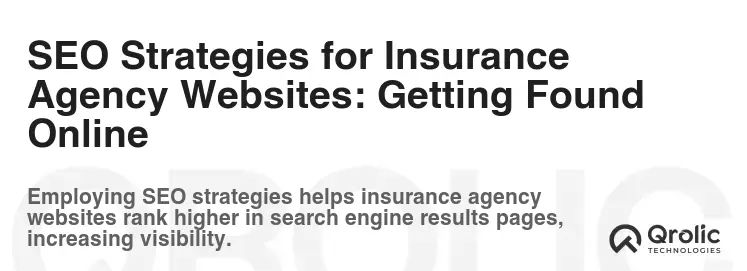
Keyword Research: Identifying the Terms Your Clients Are Searching For
SEO (Search Engine Optimization) is the process of optimizing your website to rank higher in search engine results pages (SERPs). The first step in any SEO strategy is keyword research. This involves identifying the terms and phrases that your target audience is using to search for insurance services online. Use keyword research tools to find relevant keywords with high search volume and low competition. Focus on long-tail keywords, which are longer and more specific phrases that can help you attract more qualified leads.
- Use Keyword Research Tools: Utilize tools like Google Keyword Planner, SEMrush, or Ahrefs to identify relevant keywords.
- Focus on Long-Tail Keywords: Target longer and more specific phrases that are less competitive and attract more qualified leads.
- Analyze Competitor Keywords: Research the keywords that your competitors are using to rank well in search results.
- Consider Local Keywords: Include location-based keywords to target local clients in your service area.
On-Page Optimization: Optimizing Your Website for Search Engines
On-page optimization involves optimizing the content and structure of your website to improve its ranking in search results. This includes optimizing your title tags, meta descriptions, header tags, and image alt text with relevant keywords. Create high-quality, informative, and engaging content that is optimized for both search engines and human readers. Ensure that your website is mobile-friendly, loads quickly, and is easy to navigate.
- Optimize Title Tags and Meta Descriptions: Write compelling title tags and meta descriptions that accurately describe the content of each page and include relevant keywords.
- Use Header Tags (H1-H6): Use header tags to structure your content and highlight important keywords.
- Optimize Image Alt Text: Add descriptive alt text to all images on your website, including relevant keywords.
- Create High-Quality Content: Publish informative, engaging, and original content that is optimized for both search engines and human readers.
- Internal Linking: Link to other relevant pages on your website to improve navigation and distribute link juice.
Off-Page Optimization: Building Authority and Reputation
Off-page optimization involves building your website’s authority and reputation through activities that take place outside of your website. This includes building high-quality backlinks from other reputable websites, engaging in social media marketing, and participating in online communities. Focus on building relationships with other businesses and organizations in your industry. Encourage clients to leave reviews on Google and other online review platforms.
- Build High-Quality Backlinks: Obtain backlinks from other reputable websites in your industry to improve your website’s authority.
- Engage in Social Media Marketing: Promote your website and content on social media platforms to increase brand awareness and drive traffic.
- Participate in Online Communities: Engage in online communities and forums related to insurance and risk management.
- Encourage Client Reviews: Encourage satisfied clients to leave reviews on Google and other online review platforms.
- Local Citations: Ensure your business information is consistent and accurate across all online directories and citation sites.
Local SEO: Targeting Clients in Your Geographic Area
For many insurance agencies, local SEO is crucial. Optimize your Google My Business listing to ensure that your business information is accurate and up-to-date. Include your address, phone number, website URL, and business hours. Encourage clients to leave reviews on your Google My Business listing. Use local keywords in your website content and meta descriptions. Build citations on local directories and websites.
- Optimize Google My Business Listing: Ensure that your Google My Business listing is accurate and up-to-date.
- Encourage Client Reviews on Google: Encourage satisfied clients to leave reviews on your Google My Business listing.
- Use Local Keywords: Include location-based keywords in your website content and meta descriptions.
- Build Local Citations: Build citations on local directories and websites.
- Participate in Local Events: Sponsor or participate in local events to increase your visibility in the community.
Content Marketing: Attracting and Engaging Potential Clients
Content marketing is a powerful way to attract and engage potential clients. Create valuable content that addresses their needs and interests. Publish blog posts, articles, infographics, videos, and other types of content that provide helpful information and insights. Share your content on social media and through email marketing. Use content marketing to establish yourself as a thought leader in the insurance industry.
- Blog Posts: Publish regular blog posts on topics related to insurance, risk management, and financial planning.
- Articles: Write articles for industry publications and websites.
- Infographics: Create visually appealing infographics that present complex information in an easy-to-understand format.
- Videos: Produce videos that explain insurance concepts, provide tips, and showcase your expertise.
- Email Marketing: Use email marketing to share your content with your subscribers and promote your services.
- Case Studies: Develop case studies that showcase how you’ve helped clients solve their insurance and risk management challenges.
Beyond the Basics: Advanced Website Features for Insurance Agencies
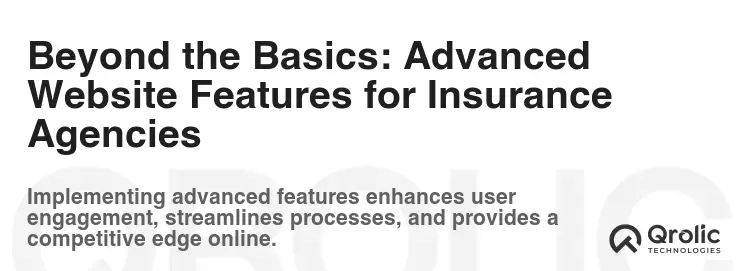
Online Quoting Tools: Streamlining the Sales Process
Implement online quoting tools that allow potential clients to get instant quotes for different types of insurance. These tools should be user-friendly, accurate, and customizable. Integrate them seamlessly into your website to provide a smooth and efficient user experience. Consider offering different levels of customization to allow users to tailor their quotes to their specific needs.
- User-Friendly Interface: Ensure that your online quoting tool is easy to use and navigate.
- Accurate Quotes: Provide accurate quotes based on the information provided by the user.
- Customizable Options: Allow users to customize their quotes by selecting different coverage options and deductibles.
- Seamless Integration: Integrate the quoting tool seamlessly into your website for a smooth user experience.
- Lead Capture: Capture user information during the quoting process to follow up with potential clients.
Client Portals: Providing Secure Access to Policy Information
Create client portals that allow clients to securely access their policy information online. These portals should provide access to policy documents, billing information, claims status, and other relevant information. Implement security measures to protect client data and ensure privacy.
- Secure Access: Implement secure login procedures to protect client data.
- Policy Information: Provide access to policy documents, coverage details, and renewal information.
- Billing Information: Allow clients to view and pay their bills online.
- Claims Status: Provide updates on the status of claims.
- Communication Tools: Integrate communication tools that allow clients to contact you directly with questions or concerns.
CRM Integration: Managing Client Relationships Effectively
Integrate your website with a CRM (Customer Relationship Management) system to manage client relationships effectively. This will allow you to track leads, manage client interactions, and automate marketing tasks. Choose a CRM that is specifically designed for the insurance industry and integrates seamlessly with your website.
- Lead Tracking: Track leads generated from your website and manage them through the sales process.
- Client Management: Store and manage client information in a centralized database.
- Marketing Automation: Automate marketing tasks such as email marketing and social media posting.
- Reporting and Analytics: Track key metrics such as website traffic, lead generation, and conversion rates.
- Integration with Other Tools: Integrate your CRM with other tools such as your email marketing platform and accounting software.
Live Chat Support: Providing Instant Assistance to Website Visitors
Implement live chat support to provide instant assistance to website visitors. This can help you answer questions, resolve issues, and generate leads. Train your staff to provide excellent customer service through live chat. Consider using a chatbot to handle basic inquiries and free up your staff to focus on more complex issues.
- Real-Time Assistance: Provide instant answers to visitor questions and resolve issues in real-time.
- Lead Generation: Capture leads through live chat interactions.
- Customer Service: Provide excellent customer service through live chat.
- Chatbot Integration: Use a chatbot to handle basic inquiries and free up your staff.
- 24/7 Availability: Consider offering 24/7 live chat support to cater to clients in different time zones.
Multi-Lingual Support: Reaching a Wider Audience
If you serve a diverse community, consider offering multi-lingual support on your website. This will allow you to reach a wider audience and provide a better user experience for clients who speak different languages. Translate your website content and provide customer service in multiple languages.
- Website Translation: Translate your website content into multiple languages.
- Customer Service in Multiple Languages: Provide customer service in multiple languages.
- Language Selection Options: Provide users with options to select their preferred language.
- Cultural Sensitivity: Be mindful of cultural differences and tailor your content and messaging accordingly.
- Local Market Research: Conduct market research to identify the languages spoken by your target audience.
Measuring Success: Website Analytics and Key Performance Indicators (KPIs)
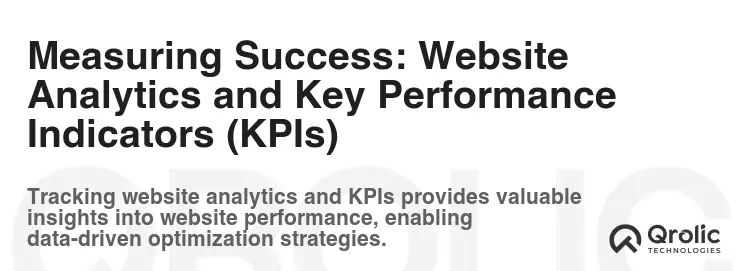
Tracking Website Traffic: Understanding Where Your Visitors Are Coming From
Use website analytics tools like Google Analytics to track website traffic and understand where your visitors are coming from. This will help you identify which marketing channels are driving the most traffic and which pages are the most popular. Analyze your website traffic data to identify areas for improvement.
- Google Analytics: Use Google Analytics to track website traffic, user behavior, and conversions.
- Traffic Sources: Identify the sources of your website traffic (e.g., organic search, paid advertising, social media).
- Popular Pages: Identify the most popular pages on your website.
- Bounce Rate: Monitor your website’s bounce rate to identify pages that need improvement.
- Conversion Rate: Track your website’s conversion rate to measure the effectiveness of your marketing efforts.
Monitoring Conversion Rates: Measuring the Effectiveness of Your Website
Monitor your website’s conversion rates to measure the effectiveness of your marketing efforts. Track the number of leads generated, quotes requested, and policies sold through your website. Analyze your conversion data to identify areas where you can improve your website’s performance.
- Lead Generation: Track the number of leads generated from your website.
- Quote Requests: Track the number of quote requests received through your website.
- Policy Sales: Track the number of policies sold through your website.
- Conversion Goals: Set conversion goals and track your progress towards achieving them.
- A/B Testing: Use A/B testing to experiment with different website designs and content to improve conversion rates.
Analyzing User Behavior: Understanding How Visitors Interact With Your Website
Use website analytics tools to analyze user behavior and understand how visitors interact with your website. Track the pages they visit, the links they click on, and the amount of time they spend on each page. Use this information to identify areas where you can improve your website’s usability and user experience.
- Page Views: Track the number of page views on each page of your website.
- Time on Page: Track the amount of time users spend on each page of your website.
- Click-Through Rates: Track the click-through rates on links and buttons on your website.
- Heatmaps: Use heatmaps to visualize how users interact with your website.
- User Surveys: Conduct user surveys to gather feedback on your website’s usability and user experience.
Key Performance Indicators (KPIs): Tracking the Metrics That Matter Most
Identify the key performance indicators (KPIs) that are most important for your insurance agency. These might include website traffic, lead generation, conversion rates, and customer satisfaction. Track these KPIs regularly and use them to measure the success of your website and marketing efforts.
- Website Traffic: The number of visitors to your website.
- Lead Generation: The number of leads generated from your website.
- Conversion Rates: The percentage of website visitors who convert into leads or customers.
- Customer Satisfaction: The level of satisfaction among your customers.
- Return on Investment (ROI): The return on investment from your website and marketing efforts.
Qrolic Technologies: Your Partner in Insurance Agency Website Design
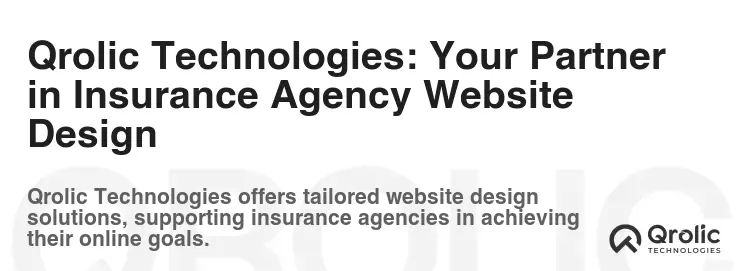
Qrolic Technologies (https://qrolic.com/) understands the unique challenges and opportunities that insurance agencies face in the digital age. We specialize in creating custom website solutions that are tailored to the specific needs of your business. Our team of experienced designers, developers, and SEO experts will work with you to create a website that is visually appealing, user-friendly, and optimized for search engines.
We offer a wide range of services, including:
- Website Design and Development: We create custom website designs that are tailored to your brand and target audience.
- SEO Optimization: We optimize your website for search engines to improve your ranking and visibility.
- Content Marketing: We create valuable content that attracts and engages potential clients.
- Social Media Marketing: We help you build your brand and connect with clients on social media.
- CRM Integration: We integrate your website with a CRM system to manage client relationships effectively.
We are committed to providing our clients with the highest level of service and support. Contact us today to learn more about how we can help you create a website that drives results for your insurance agency.
The Future of Insurance Agency Websites: Trends to Watch
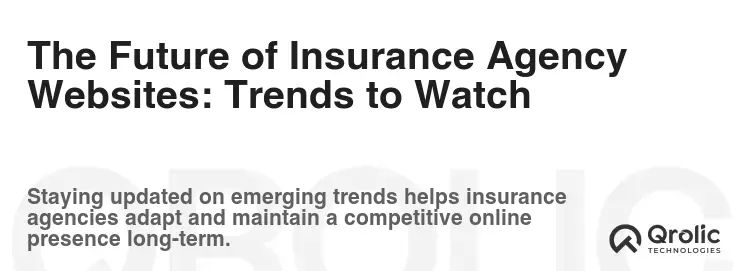
Artificial Intelligence (AI) and Chatbots: Personalized Customer Interactions
AI and chatbots are transforming the way businesses interact with their customers. Insurance agencies can use AI-powered chatbots to provide instant support, answer questions, and generate leads. AI can also be used to personalize the user experience on your website and provide tailored recommendations based on individual needs.
Video Marketing: Engaging Content That Converts
Video marketing is becoming increasingly important for businesses of all sizes. Insurance agencies can use video to explain complex concepts, showcase their expertise, and build trust with potential clients. Create videos that are informative, engaging, and visually appealing.
Voice Search Optimization: Preparing for the Future of Search
Voice search is becoming increasingly popular as more and more people use voice assistants like Siri and Alexa. Optimize your website for voice search by using natural language keywords and answering common questions that people ask through voice search.
Data Analytics and Personalization: Delivering Tailored Experiences
Data analytics is becoming increasingly sophisticated, allowing businesses to personalize the user experience on their websites. Insurance agencies can use data analytics to understand their clients’ needs and preferences and provide tailored recommendations and offers.
Accessibility: Ensuring Your Website is Usable by Everyone
Accessibility is an important consideration for all websites. Ensure that your website is usable by people with disabilities by following accessibility guidelines such as WCAG. This will not only make your website more inclusive but also improve its usability for all users.
By embracing these trends, insurance agencies can stay ahead of the curve and create websites that are effective, engaging, and accessible to all. Your website is not just a digital brochure; it’s a powerful tool that can help you attract new clients, build relationships, and grow your business.

